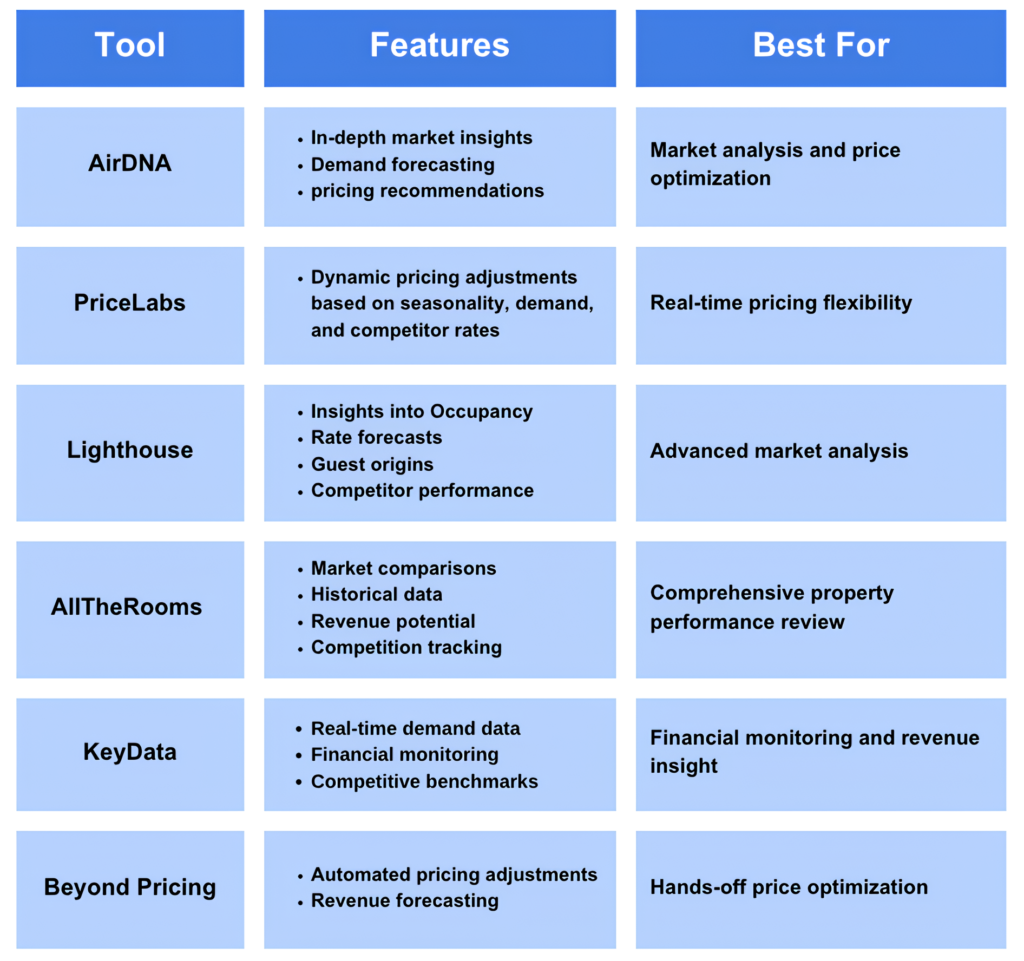Navigating the world of short-term rentals can feel overwhelming, especially when you’re looking to move beyond basic hosting and really grow your Airbnb business. It’s tempting to rely on intuition or advice from fellow hosts, but using the right data can give you a serious edge. By taking advantage of data-driven strategies, you can increase bookings, optimize pricing, and maximize occupancy without the guesswork. In this guide, we’ll walk you through which data matters most, how to use it effectively, common pitfalls to watch out for, and some of the best tools to keep your rental thriving. Let’s dive in!
Key Data Types to Help You Thrive in Short-Term Rentals
Let’s start with the basics: what types of data should you actually pay attention to? Here are some of the most helpful ones we’ve seen hosts use to grow their businesses and reach their goals:
Pricing & Rate Data
Knowing how to price your property is a big game-changer. Hosteeva’s Smart Pricing feature uses real-time market data to automatically adjust rates, helping you maximize revenue and occupancy. This feature brings the same sophisticated pricing strategy used by large hotels to your short-term rental business.
Occupancy Trends
Occupancy trends aren’t just about knowing when your property is booked; they’re about spotting patterns. For example, if you know summers are always busy, you can plan targeted promotions to fill up those shoulder seasons. Tracking this over time lets you stay one step ahead.
Guest Preferences
Learning about who’s staying in your property and why can be a goldmine for boosting bookings. For instance, if you notice many of your guests are families, adding amenities like a high chair or crib could make your property even more appealing. Business travelers? A comfortable workspace and fast Wi-Fi could be just what they’re looking for.
Revenue Breakdown
Tracking where your revenue comes from and where it goes is crucial. Understanding which booking sources bring in the most income, which months or weeks are most profitable, and where expenses tend to spike gives you a clearer picture of your property’s financial health.
Feedback and Review Analysis
Guest feedback can be one of the most underrated sources of data. It can highlight little tweaks that might make a huge difference in guest satisfaction, like updating your check-in instructions or adding extra pillows. Plus, consistently improving based on feedback often leads to better reviews and more bookings. Hosteeva’s Eva AI Assistant can even automate guest replies and help you manage reviews seamlessly, allowing you to stay engaged with guests without the extra effort.
Booking Sources
Diversifying where your bookings come from—whether it’s Airbnb, Vrbo, or direct bookings through your own website—gives you more control over your business. If you notice that one platform brings in more income or longer stays, you can prioritize that channel, but keeping a balance helps reduce your dependence on any single one.
Data-Driven Strategies to Boost Your Airbnb Business
Once you have these data points in place, here’s how you can turn them into real strategies:
Adjust Your Approach Seasonally
Don’t wait until your occupancy drops to start thinking about slower months! Use data to identify low seasons and offer special deals or adjust minimum stay requirements to keep occupancy up. Conversely, don’t be afraid to increase your minimum stays or raise rates during peak times to maximize profits. Seasonal adjustments in pricing and stay requirements can significantly impact your revenue. For additional tips on seasonal revenue strategies, see our guide on Unlock & Learn Episode 13: Distribution Trends, Revenue Growth, and Your Conference Prep Guide.
Personalize Your Marketing by Guest Type
Data can tell you a lot about who stays with you, so why not use it to market smarter? If your guests are often families or long-term renters, target your marketing toward them by emphasizing the things they care about (like a fully equipped kitchen or outdoor space).
Adjust Pricing Dynamically
It’s tempting to “set it and forget it” when it comes to pricing, but small tweaks can make a big difference. Tools that adjust your pricing based on demand help you stay competitive without having to constantly monitor rates yourself. This ensures you’re not leaving money on the table or scaring away potential guests with sky-high rates during slower periods.
Address Feedback to Improve Guest Experience
Take a little time every so often to look at your reviews and spot patterns. Maybe guests love your place but wish for blackout curtains, or they might mention needing clearer directions for check-in. Making small adjustments based on feedback shows guests you care, which is a surefire way to build loyalty and attract repeat bookings.
Common Mistakes to Avoid in Data-Driven Hosting
Even with great data, it’s easy to fall into some common traps. Here are a few to watch out for:
Focusing Too Much on Occupancy
Occupancy is great, but full occupancy at low rates can mean you’re not maximizing your property’s potential. It’s a balance; rather than aiming for 100% occupancy, try for the highest revenue you can get with a combination of good rates and steady bookings.
Ignoring Competitor Insights
Keeping an eye on your competition helps you see trends in real time. Maybe similar properties are dropping rates or adding amenities. Using competitor data wisely keeps you in the loop and lets you respond to the market quickly.
Forgetting to Adjust Seasonally
Some hosts find a pricing or booking strategy that works and stick with it year-round. But the market changes, sometimes month to month! If you’re not reviewing your strategy seasonally, you might miss out on opportunities to capture demand when it’s high or adjust during slower times.
Comparison of Top Tools to Help You Leverage Data
There are many tools available to help you optimize pricing, monitor occupancy, and analyze guest trends. Some of the most popular include AirDNA, PriceLabs, Lighthouse (Formerly OTA Insight), AllTheRooms, KeyData, and Beyond Pricing. Here’s a quick comparison to help you choose the right one for your needs:

Each of these tools brings unique advantages, so it depends on your goals. For example, AirDNA and Lighthouse are fantastic for overall market insights, PriceLabs and Beyond Pricing handle dynamic rate adjustments with ease, and KeyData is great for tracking financial health and revenue breakdowns.
Conclusion and Key Takeaway
Growing your Airbnb business with data doesn’t have to be complex. By focusing on relevant metrics—like pricing trends, occupancy patterns, and guest preferences—and turning them into actionable strategies, you can create a thriving, sustainable business. Remember to keep an eye on competitor data, adjust seasonally, and use tools to automate where you can. With the right mix of data and a bit of strategy, you’ll find it easier to increase bookings, enhance guest experience, and watch your revenue grow. Happy hosting!




